I am very intrigued by the Open Source Monkey Box project, Troels' Loudspeaker III, and much of the stuff from DIYsoundgroup... but I have a unique goal with my studio monitor project:
1) Attempt to compromise between a few conflicting use cases.
2) Smooth enough balance and accurate enough to do some audio engineering and mixing. (low-medium priority)
3) "voiced" to allow for plenty of general music listening and music appreciation (medium priority)
4) Able to meet the demands as a tracking monitor for drums, guitar, bass and keyboards (medium-high priority)
5) Able to meet the demands of an FRFR powered speaker to use with guitar/bass amp modelers and thus bypass the need to have actual guitar amps and bass amps in my bedroom studio (high priority, as most of the time I am going to be practicing or goofing around on bass, guitar, and keyboards and these will serve as my "amp")
6) Help me avoid feeling like I should have spent the money on high end studio monitors like a Dynaudio Core 59 or Adam S3H, and then also spent the money on a good FRFR option like a QSC K12.2 and instead have something that kind of, sort of, maybe... does a fair job of blending all of their strengths into one system.
So, in pursuit of these goals, I have come with these components, and thinking of a driver/baffle layout similar to Dynaudio Core 59 in horizontal position but in a much bigger box to give the woofer I am thinking of using the room it needs to perform close to optimum:
Hypex FusionAmp FA252
Hypex FusionAmp FA501
Radian LT6 waveguide
Faital Pro 6PR160
Faital Pro 15PR400 4 ohm
I know that a good passive crossover will probably give me a better HiFi speaker, but I just want to keep it simple and give myself room to make major modifications down the road if need be.
I am fairly certain I will stick with the Radian LT6 in their waveguide and be an early adopter on this one unless I hear some bad things about it.
I "think" the 15PR400 makes the most sense as the woofer given all my goals above, but open to ideas
Not at all sure about the 6PR160 so could really use some advice about the best mid driver to use between this woofer and tweeter. I am expecting my digital crossover points to be in the ballpark of 300 Hz and 2kHz give or take a bit.
Please fire away with any thoughts, observations, alternative ideas, etc...
Note: I do have Focal Alpha 65 and Kali Audio IN-5 to use with my computer and to help with any final mixing mastering or home recording projects and just general music listening at my computer desk, so these big DIY monitors will be driven directly from my mixing board (Allen & Heath SQ-7 is in my very near future) and serve as "instrument monitors" and be ready to rock out when I just feel like listening to something big and loud 🙂
1) Attempt to compromise between a few conflicting use cases.
2) Smooth enough balance and accurate enough to do some audio engineering and mixing. (low-medium priority)
3) "voiced" to allow for plenty of general music listening and music appreciation (medium priority)
4) Able to meet the demands as a tracking monitor for drums, guitar, bass and keyboards (medium-high priority)
5) Able to meet the demands of an FRFR powered speaker to use with guitar/bass amp modelers and thus bypass the need to have actual guitar amps and bass amps in my bedroom studio (high priority, as most of the time I am going to be practicing or goofing around on bass, guitar, and keyboards and these will serve as my "amp")
6) Help me avoid feeling like I should have spent the money on high end studio monitors like a Dynaudio Core 59 or Adam S3H, and then also spent the money on a good FRFR option like a QSC K12.2 and instead have something that kind of, sort of, maybe... does a fair job of blending all of their strengths into one system.
So, in pursuit of these goals, I have come with these components, and thinking of a driver/baffle layout similar to Dynaudio Core 59 in horizontal position but in a much bigger box to give the woofer I am thinking of using the room it needs to perform close to optimum:
Hypex FusionAmp FA252
Hypex FusionAmp FA501
Radian LT6 waveguide
Faital Pro 6PR160
Faital Pro 15PR400 4 ohm
I know that a good passive crossover will probably give me a better HiFi speaker, but I just want to keep it simple and give myself room to make major modifications down the road if need be.
I am fairly certain I will stick with the Radian LT6 in their waveguide and be an early adopter on this one unless I hear some bad things about it.
I "think" the 15PR400 makes the most sense as the woofer given all my goals above, but open to ideas
Not at all sure about the 6PR160 so could really use some advice about the best mid driver to use between this woofer and tweeter. I am expecting my digital crossover points to be in the ballpark of 300 Hz and 2kHz give or take a bit.
Please fire away with any thoughts, observations, alternative ideas, etc...
Note: I do have Focal Alpha 65 and Kali Audio IN-5 to use with my computer and to help with any final mixing mastering or home recording projects and just general music listening at my computer desk, so these big DIY monitors will be driven directly from my mixing board (Allen & Heath SQ-7 is in my very near future) and serve as "instrument monitors" and be ready to rock out when I just feel like listening to something big and loud 🙂
Last edited:
You may follow the Loudspeaker III designs just as they are. However, since an opinion has been asked for, I'd say the following.
The 15PR400 is the higher sensitivity type of driver that is mostly used in sound reinforcement. I believe that it is linearity (not sensitivity) that needs to be the preference when it comes to studio applications.
If you're in the US, do have a look at JBL drivers. Their 2235H is said to be very linear, but rare. 2214H / 2216Nd are newer designs. 2216Nd is the driver used in the JBL M2 Reference monitor. Also note that 2214H is 12".
https://jblpro.com/en/site_elements...er-list-for-jbl-professional-cone-transducers
The 15PR400 is the higher sensitivity type of driver that is mostly used in sound reinforcement. I believe that it is linearity (not sensitivity) that needs to be the preference when it comes to studio applications.
If you're in the US, do have a look at JBL drivers. Their 2235H is said to be very linear, but rare. 2214H / 2216Nd are newer designs. 2216Nd is the driver used in the JBL M2 Reference monitor. Also note that 2214H is 12".
https://jblpro.com/en/site_elements...er-list-for-jbl-professional-cone-transducers
Last edited:
Thank you newvirus2008 ... I would consider spending a little extra on a JBL woofer, but I am not familiar with the models you listed however I will check them out. The one that seems most often recommended and available is the 2226H as far as I can tell.
If anyone has some experience/knowledge about these woofers and can give me a quick idea about pros/cons for my application it would be greatly appreciated.
I do understand the need for good linearity and balance in all the drivers for mixing/mastering, but please keep in mind that of my objectives, this would be one of the lower priorities.
I should also add that although my highest priority is selecting a woofer that will do well with me cranking my bass guitars through it on a regular basis (and keyboards and drum machines) I also do not plan on adding subs at any point so for general music listening it is important to me that will a little nudge from the Hypex DSP and adequate power that I can get very satisfying levels of low bass in the mid to high 30s range. Getting within -3db to at least 40 Hz and preferably just under that is very important to me while getting that level of accuracy under 30 Hz is completely unimportant to me.
If anyone has some experience/knowledge about these woofers and can give me a quick idea about pros/cons for my application it would be greatly appreciated.
I do understand the need for good linearity and balance in all the drivers for mixing/mastering, but please keep in mind that of my objectives, this would be one of the lower priorities.
I should also add that although my highest priority is selecting a woofer that will do well with me cranking my bass guitars through it on a regular basis (and keyboards and drum machines) I also do not plan on adding subs at any point so for general music listening it is important to me that will a little nudge from the Hypex DSP and adequate power that I can get very satisfying levels of low bass in the mid to high 30s range. Getting within -3db to at least 40 Hz and preferably just under that is very important to me while getting that level of accuracy under 30 Hz is completely unimportant to me.
Last edited:
Have a look at this document here. It's old but very useful stuff.
http://www.cieri.net/Documenti/JBL/Technical Notes/JBL Technical Note - Vol.1, No.3A.pdf
If editing / mixing is not a priority then you may also consider several others such as 2035H, 265H-1 etc. that go for similar prices as the Faital pro you mentioned. 2226H is for high power application and therefore very expensive in my opinion.
I am sure there are others who know these drivers in and out. Just have to wait until they decide to join in.
http://www.cieri.net/Documenti/JBL/Technical Notes/JBL Technical Note - Vol.1, No.3A.pdf
If editing / mixing is not a priority then you may also consider several others such as 2035H, 265H-1 etc. that go for similar prices as the Faital pro you mentioned. 2226H is for high power application and therefore very expensive in my opinion.
I am sure there are others who know these drivers in and out. Just have to wait until they decide to join in.
Thanks for the link! Gave that JBL paper a quick glance but will definitely give it a thorough read over the next few days.
Have you seen these?
http://www.humblehomemadehifi.com/download/Humble Homemade Hifi_Calpamos.pdf
I've got the faital 15", great driver, versatile.
http://www.humblehomemadehifi.com/download/Humble Homemade Hifi_Calpamos.pdf
I've got the faital 15", great driver, versatile.
I have not !!! Can't believe I missed that speaker project, that is a serious contender for me, especially getting the crossovers pre-assembled and tested as part of the kit. I will need to look into the price plus shipping in US dollars, but I would guess that for music they will sound better than anything I would do on my own with DSP and for everything else they probably meet my criteria just fine given that they are pro drivers. Thank you for this, it has me giving some very serious thought as to if I should really go this alone with my own custom project. I am a big fan of Klipsch and Harbeth, and this Calpamos project from Tony Gee just might deliver something in between those two that I really like.
I really didn't think I would ever consider a 2-way, but this one does have me thinking... and even though I would prefer a horizontal orientation to kind of mimic the classic studio monitor vibe, putting something like this on stands that get at least the top half of the woofer peeping over the mixing board is a more than adequate solution as far as I am concerned.
I really didn't think I would ever consider a 2-way, but this one does have me thinking... and even though I would prefer a horizontal orientation to kind of mimic the classic studio monitor vibe, putting something like this on stands that get at least the top half of the woofer peeping over the mixing board is a more than adequate solution as far as I am concerned.
Last edited:
Happy to help. That's a lovely looking speaker.
Just in case you missed it but Troels used the faital 15" in this design too.
Faital-3WC-15
Just in case you missed it but Troels used the faital 15" in this design too.
Faital-3WC-15
I'm in the same boat, trying to design a 4 way monitor system. So far my driver selection is -
SB Acoustics SB34NRXL75-8 13" LF driver
B&C 8NDL51 8" cone midbass driver
Scan Speak/Vifa D75MX-41-08 3" dome midrange
Seas T35-C002 1.4" dome tweeter
I'm aiming for 91-92 dB@1W/1m system efficiency. Crossover points 300Hz, 900Hz, 3500Hz
I looked at quite a few drivers and ended up with my choices based on low THD, 110+ dB output capability across 30Hz - 16kHz +/- 1.5dB in a sealed cabinet with minimal phase shift. Being able to run a passive xover was important to me but I'll be biamping the LF and MF separately with 2 Parasound A21s for more headroom and separate stereo subwoofers with SB34NRX75-6 woofers and Speaker Power SP1-700 class D plate amps also in sealed cabinets.
I considered JBL 2206H LF drivers and going 3 way. They are great low distortion LF drivers, but running a 12" up to 900Hz and keeping THD low isn't easy, plus it won't play low enough to run without the help of separate subs.
In your case, the B&C 8PE21 would be a great fit IMO. Its around 98dB/W efficient, flat from 400Hz - 4kHz and has low THD. It will easily play over 120dB as well.
For a decent 15" LF driver that goes low enough in a ported cab for your needs, the B&C 15PS100 is a really nice LF driver. Its flat to over 1kHz and plays down past 40Hz in a vented cab with very low THD, plus it has a dual spider and 4" copper VC on a fiberglass former, which is a extremely durable and low damping VC. That reduces power compression over less durable aluminum VC windings on a weaker kapton former.
For HF why not consider the Beyma TPL150H? It's a little pricey, but is one of the best planar pro drivers I've heard. It can play insanely clean and loud at the same time, plus it goes low enough to mate with just about any cone mid in existence.
BTW, I'm a bassist myself. There's nothing worse than not being able to hear well defined, clean low end.
SB Acoustics SB34NRXL75-8 13" LF driver
B&C 8NDL51 8" cone midbass driver
Scan Speak/Vifa D75MX-41-08 3" dome midrange
Seas T35-C002 1.4" dome tweeter
I'm aiming for 91-92 dB@1W/1m system efficiency. Crossover points 300Hz, 900Hz, 3500Hz
I looked at quite a few drivers and ended up with my choices based on low THD, 110+ dB output capability across 30Hz - 16kHz +/- 1.5dB in a sealed cabinet with minimal phase shift. Being able to run a passive xover was important to me but I'll be biamping the LF and MF separately with 2 Parasound A21s for more headroom and separate stereo subwoofers with SB34NRX75-6 woofers and Speaker Power SP1-700 class D plate amps also in sealed cabinets.
I considered JBL 2206H LF drivers and going 3 way. They are great low distortion LF drivers, but running a 12" up to 900Hz and keeping THD low isn't easy, plus it won't play low enough to run without the help of separate subs.
In your case, the B&C 8PE21 would be a great fit IMO. Its around 98dB/W efficient, flat from 400Hz - 4kHz and has low THD. It will easily play over 120dB as well.
For a decent 15" LF driver that goes low enough in a ported cab for your needs, the B&C 15PS100 is a really nice LF driver. Its flat to over 1kHz and plays down past 40Hz in a vented cab with very low THD, plus it has a dual spider and 4" copper VC on a fiberglass former, which is a extremely durable and low damping VC. That reduces power compression over less durable aluminum VC windings on a weaker kapton former.
For HF why not consider the Beyma TPL150H? It's a little pricey, but is one of the best planar pro drivers I've heard. It can play insanely clean and loud at the same time, plus it goes low enough to mate with just about any cone mid in existence.
BTW, I'm a bassist myself. There's nothing worse than not being able to hear well defined, clean low end.
Last edited:
Hi fellow LF noise makers
Vance Dickason once mentioned in the Voice Coil magazine that he had built himself a two-way studio monitor with a B&C 15BG100. If this is usable for a two way it will definitely work for a three way.
And yes, big monitor-like speakers are definitely fun for domestic bass-playing. Expecially when you have a low B.
Regards
Charles
Vance Dickason once mentioned in the Voice Coil magazine that he had built himself a two-way studio monitor with a B&C 15BG100. If this is usable for a two way it will definitely work for a three way.
And yes, big monitor-like speakers are definitely fun for domestic bass-playing. Expecially when you have a low B.
Regards
Charles
In case you're looking for a guitar-specific monitor driver, Eminence makes so many of those. They also seem to have a speaker selector (based on adjectives) on their website: They also have coaxial drivers that enable full-range operation with compression drivers riding on their backs.
Guitar Speaker Tone Guide | Eminence Speaker
However, do remember that these don't carry the neutral sound character of studio monitors used in audio editing and mixing.
Guitar Speaker Tone Guide | Eminence Speaker
However, do remember that these don't carry the neutral sound character of studio monitors used in audio editing and mixing.
Last edited:
The dynamic range of an electric bass or guitar without compression is pretty harsh on hifi speakers. Most modellers have compression options built in, make sure those are active and have appropriate settings.
I am not really convinced you will be able to arrive at a satisfying compromise between enjoyable listening of canned material on the one hand and use as instrument amp on the other. It might be actually be easier, and cheaper, to get two systems. The only upside I see is space.
I am not really convinced you will be able to arrive at a satisfying compromise between enjoyable listening of canned material on the one hand and use as instrument amp on the other. It might be actually be easier, and cheaper, to get two systems. The only upside I see is space.
It may be possible to use cinema speakers for both. However, neither do those qualify as "high fidelity" nor do they come cheap, which makes it a lot easier to have two separate setups, as pointed out by geotone. A very low fs (20-30Hz), low Vas driver in a sealed box may be worth a try. If the driver has lots of Xmax to offer, then a Linkwitz transform can also be added to extend the bass further.
I don't think SPL would be a problem as it is an indoor application.
I don't think SPL would be a problem as it is an indoor application.
Last edited:
To start things off, this is a 125 litre sealed box with a 35Hz lower limit using the JBL W15GTi. I believe the JBL 2256G would also work just fine. Do note that this is a driver with a very high Mms (260g) and therefore would never ever qualify for a studio monitor driver.
Box details, Power applied, EQ settings, Cone excursion, Response, Group delay, SPL, Amplifier power, Impedance.
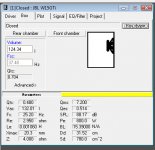
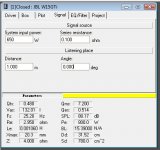
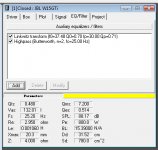
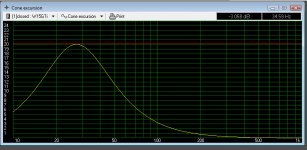
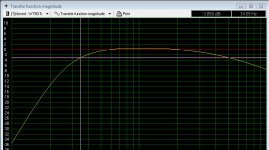

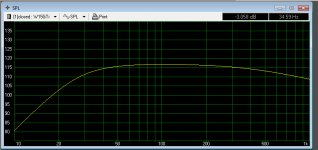
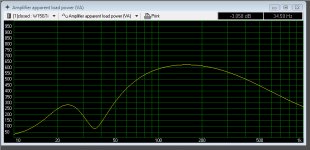
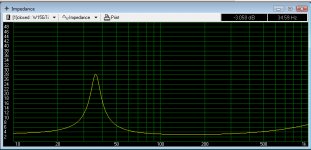
Box details, Power applied, EQ settings, Cone excursion, Response, Group delay, SPL, Amplifier power, Impedance.









Last edited:
Thanks everyone for all the great feedback. I have run instruments live during tracking sessions through regular studio monitors and they seem to do OK but I was always very careful and usually had a compressor in the signal chain somewhere.
I am confident that the drivers I have listed are quite capable of managing any live instrument/vocal signal without any problems in a residential recording space as these same drivers are also often used in actual amp cabs anyways. But yes, using compression in the signal chain will still be a good idea.
And yes, I am making some compromises here, but I don't think it is really all that much at the end of the day... but mostly in the name of simplicity and space. I already have Headrush FRFR-108 and Focal Alpha 65, but hope to get rid of both of them after I complete this project.
I am seeing far too many very successful projects for home hifi listening that are using pro sound drivers to ignore the possibility of a good overlap and looking for true "dual use" if you will. I think it is easily doable and while I might still wish I had dedicated amps or PA speakers along with dedicated studio monitors, I don't think I will feel that way very often and will more likely find myself smiling that I can have it all in one rather big box. The downsize will be size and weight, but I won't really be moving things around more than once or twice a year.
I am confident that the drivers I have listed are quite capable of managing any live instrument/vocal signal without any problems in a residential recording space as these same drivers are also often used in actual amp cabs anyways. But yes, using compression in the signal chain will still be a good idea.
And yes, I am making some compromises here, but I don't think it is really all that much at the end of the day... but mostly in the name of simplicity and space. I already have Headrush FRFR-108 and Focal Alpha 65, but hope to get rid of both of them after I complete this project.
I am seeing far too many very successful projects for home hifi listening that are using pro sound drivers to ignore the possibility of a good overlap and looking for true "dual use" if you will. I think it is easily doable and while I might still wish I had dedicated amps or PA speakers along with dedicated studio monitors, I don't think I will feel that way very often and will more likely find myself smiling that I can have it all in one rather big box. The downsize will be size and weight, but I won't really be moving things around more than once or twice a year.
I build almost everything for both recording and home hifi use. There's no reason it can't be done this way. For me, if a speaker can't at least reproduce rms levels well into the 100 dB area, its useless to me. The only exception is the little auratones, which I like to use for bandwidth limited reference on vocals or other mono sources. Otherwise I don't bother with anything that can't go loud and down to 40Hz.
The thing to understand is electric bass has a louder 2nd harmonic than its fundamental frequency. Your brain reconstructs the lower fundamental when it hears it that way and thats how we got away with playing a 5 string bass through an older amp that rolls of at 50Hz (like an old Ampeg B15 Portaflex).
If you like your bass DI-ed, playing it directly through a PA or monitor system sounds bland and boring without some compression. I usually mix compressed DI bass with some kind of miced tube combo amp and side chain the DI signal from it through an LA2 (the real thing, not modeled in DAW).
Most of the B&C drivers are really nice and very affordable for what they offer. The 15PS100 is one of my favorite 15" pro woofers. I havent tried the 15BG100 yet, but if its anything like their other drivers, I'm sure its a decent driver considering Vance Dickason used it in one of his designs.
The thing to understand is electric bass has a louder 2nd harmonic than its fundamental frequency. Your brain reconstructs the lower fundamental when it hears it that way and thats how we got away with playing a 5 string bass through an older amp that rolls of at 50Hz (like an old Ampeg B15 Portaflex).
If you like your bass DI-ed, playing it directly through a PA or monitor system sounds bland and boring without some compression. I usually mix compressed DI bass with some kind of miced tube combo amp and side chain the DI signal from it through an LA2 (the real thing, not modeled in DAW).
Most of the B&C drivers are really nice and very affordable for what they offer. The 15PS100 is one of my favorite 15" pro woofers. I havent tried the 15BG100 yet, but if its anything like their other drivers, I'm sure its a decent driver considering Vance Dickason used it in one of his designs.
Have you seen these?
http://www.humblehomemadehifi.com/download/Humble Homemade Hifi_Calpamos.pdf
I've got the faital 15", great driver, versatile.
Thank you for sharing it that's an awesome affordable proyect.
In case you're looking for a guitar-specific monitor driver, Eminence makes so many of those.
A guitar speaker is an essential part of the instrument and therefore accurate reproduction is NOT part of their design brief. They are chosen specifically because their inaccuracies.
Yes that is very true. However, the OP is ok running guitar practice through the neutral studio monitors with the appropriate compressor included somewhere in the signal chain. It is further mentioned that he is already in possession of such guitar-specific models and is now looking for a pro solution that "fits all".
Now, in the pro segment, there are three sound quality levels from PA (lowest) to theatre / cinema (best of both) to studio (highest). Since the usage would be within closed spaces, the OP chooses a studio monitor, so that his general music interests are also well-addressed. Further, he expects the DIY approach to help bring things down to a more "affordable" level.
Thus, the only problem I see is the OP's choice for the studio monitor being a PA-grade driver primarily designed for loudness. Everything else seems to be quite achievable.
Now, in the pro segment, there are three sound quality levels from PA (lowest) to theatre / cinema (best of both) to studio (highest). Since the usage would be within closed spaces, the OP chooses a studio monitor, so that his general music interests are also well-addressed. Further, he expects the DIY approach to help bring things down to a more "affordable" level.
Thus, the only problem I see is the OP's choice for the studio monitor being a PA-grade driver primarily designed for loudness. Everything else seems to be quite achievable.
Last edited:
There are lots of studio monitors out there using PA drivers. I don't see a general problem with this.
Regards
Charles
Regards
Charles
- Home
- Loudspeakers
- Multi-Way
- Big Studio Monitor - need advice :)